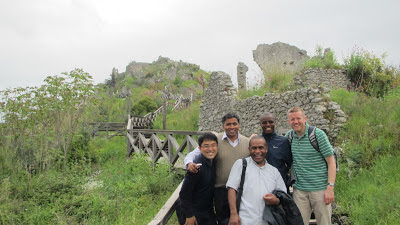Question: What happens when you go to a Dominican School?
Answer: Everyone gets really excited about St. Thomas Aquinas!
Let me explain...
St. Thomas was a 13th century philosopher and theologian who pretty much set the course for much of the theology that would follow him (even until today). His most famous work is the "Summa" which, after having had a mystical experience, he called "worth nothing more than straw." And, he was a Dominican (ahhh, now the riddle makes sense.)
In this spirit, my school took a trip a few weeks ago in the footsteps of Thomas.
Our first stop was Fossanova, a few hours from Rome. It is here, in a Cistercian Abbey, that Thomas died. He was on his way to the Council of Lyons when he fell ill. (Interestingly, his fellow theologian, and rival, St. Bonaventure died at the Council of Lyons under suspicious circumstances.) Now, Thomas was a rather large individual, and was given an upper room with a narrow staircase (I can attest to that). Because he could not easily go up and down the stairs, he took his meals in his room. And, as the story goes, after he died, the monks decided to boil his body so that it would be easier to bury. After all, as one Dominican told us on the trip, it's the bones as relics that are the most important!
 |
| From the cloister of the Abbey. |
 |
| Inside the Church |
 |
| In St. Thomas' room - a depiction of his last days. |
 |
| St. Thomas' room is on the top floor, left side. |
 |
| Fossanova |
Next, we found our way to Roccasecca. Here, Thomas was born into a slightly noble family (they weren't the richest in the area, but had titles nonetheless.) The remains of the family castle are still on the top of the hill. It was a bit of a climb, but well worth the views at the end.
 |
| Before setting out, we had to stop for a little to eat. |
 |
| In his younger years, St. Thomas was a shooting guard. |
 |
| The present day city. |
 |
| Me. |
 |
| Looking up to Thomas' family castle. |
 |
| Of course, there are always sisters hanging around :) |
 |
| Some of the ruins of the castle. |
 |
| Don't worry, I know where we're going. |
 |
| A church built to accommodate the Medieval pilgrims on their way to the top of the hill. |
 |
| Almost to the top. |
 |
| Thomas' home from down below. |
Finally, we came to Monte Cassino. Thomas went to school at the Benedictine Abbey here. However, it is more famous for being the first monastery founded by St. Benedict in the 6th century. It was sacked by the barbarians a few times, and succumbed to an earthquake, so it has been rebuilt a few times. But, in 1944, the Allied Troops, thinking that the Nazis were hiding in the abbey, completely obliterated the complex. Unfortunately, the Allies had bad information, and the Nazis were actually in the surrounding hillside. The Abbey, however, has been completely reconstructed according to the specifications of the "rebuilt" monastery. So, basically it looks the same, just several hundred years newer!
 |
| The outside of the Abbey Church. |
 |
| And the inside of the church. |
 |
| The tomb of St. Benedict and his sister, St. Scholastica. (I'm not holding my breath for another brother-sister saintly duo from my family :) |
 |
| Some of the cloister. |
 |
| St. Scholastica |
 |
| In St. Benedict's cell. It was pretty cool to be in his actual room. |
 |
| Painting of St. Benedict writing his Rule of Life. |
 |
| The original door to the monastery. It was through here that the monks escaped during the bombing |
 |
| It was a foggy afternoon. And because the monastery is built on top of a mountain, we were really in the clouds. |
 |
| St. Benedict. |
 |
| Bro. Dan and Bro. Chinnaiah with St. Benedict and friends. |
 |
| Outside the main door. It was raining, too, that day. |
 |
| The courtyard. |
Ciao!






























I love St. Thomas's basketball hoop. AMAZING it is still usable after all these years!!!
ReplyDelete